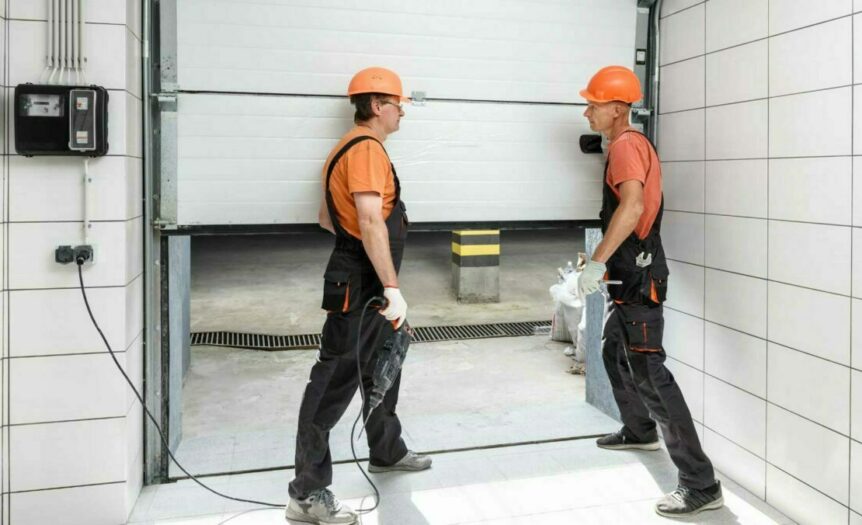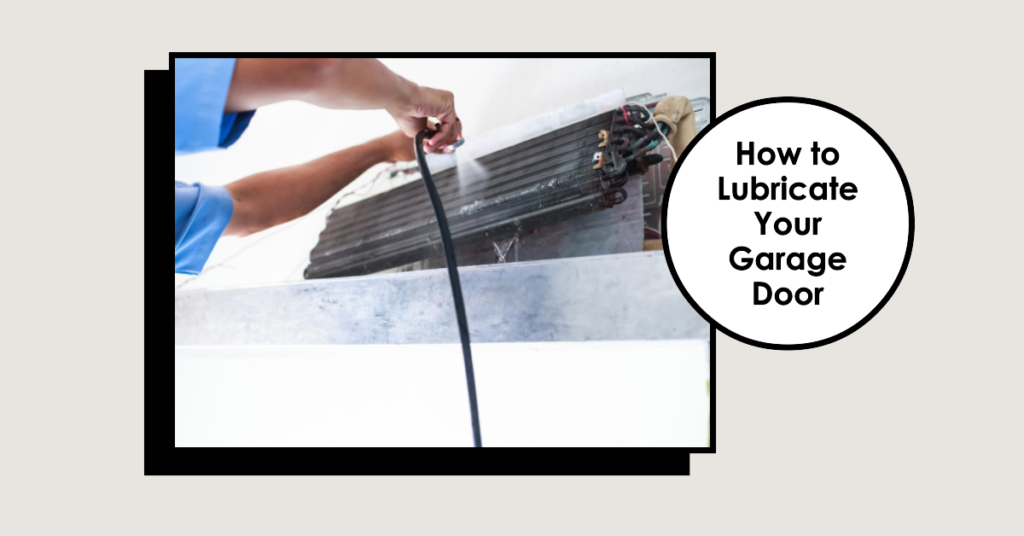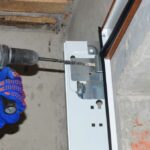A well-functioning garage door is essential for any homeowner, but it’s often overlooked until there’s a problem. One crucial aspect of garage door maintenance is lubrication, which can significantly extend its lifespan and keep things running smoothly and quietly.
In this easy-to-follow guide, we’ll show you how to lubricate your garage door like a pro, saving you time and money in the long run.
Key Takeaways
- Lubricating your garage door prevents rust and corrosion, ensures quieter operation and extends its lifespan.
- Clean the door and tracks thoroughly before applying lubricant to prevent debris buildup that could obstruct smooth operation of the door.
- Inspect your garage door every six months for wear or damage and follow a regular maintenance routine including tightening loose parts and repairing damaged parts.
- Professional maintenance services can help identify small issues early on, preventing them from turning into bigger problems.
Why Lubricating Your Garage Door Is Important
Lubricating your garage door is crucial in preventing rust and corrosion, reducing wear and tear, ensuring quieter operation, and ultimately extending the overall lifespan of the garage door.
Prevents Rust And Corrosion
One of the key benefits of lubricating your garage door is that it helps prevent rust and corrosion. Rust can be a major problem for metal doors, especially in areas with high humidity or frequent exposure to water.
A great example to illustrate this point is considering how vehicles are prone to rusting if left untreated. Similarly, without proper lubrication, your garage door’s metal components will gradually suffer from rust and corrosion over time.
This compromises the structural integrity and smooth operation of the entire system.
Quieter Operation
Lubricating your garage door can make a huge difference in how quietly it operates. Without regular lubrication, parts such as the springs and rollers can start to squeak or even grind against each other, causing loud and annoying noise.
By applying synthetic or silicone-based grease to these moving parts, you’ll reduce friction and wear-and-tear on the door’s components. This not only quiets down your garage door but also helps prolong its lifespan by reducing strain on its mechanical systems.
Reduces Wear And Tear
Regularly lubricating your garage door can significantly reduce wear and tear on the moving parts, such as the springs and rollers. Over time, without proper lubrication, these parts can become clogged with dirt and dust or begin to corrode.
By applying lithium grease or silicone lubricant spray to the moving parts of your garage door, you can ensure that it operates smoothly and quietly while minimizing damage caused by excessive wear and tear.
Extends The Lifespan Of The Door
Regular lubrication of your garage door’s moving parts extends its lifespan by reducing wear and tear. By keeping the door operating smoothly, you’ll also avoid damaging it due to sudden jerks or stops.
This is especially important with older doors that may have accumulated dirt and debris in their tracks over time, causing them to become less effective at opening and closing.
Moreover, keeping your garage door well maintained can save you money on costly repairs down the road. At least twice a year, be sure to inspect all components for signs of wear or damage and perform any necessary maintenance tasks such as tightening loose bolts or replacing worn rollers.
Step-by-Step Guide To Lubricating Your Garage Door
Follow these simple steps to lubricate your garage door and keep it running smoothly. From inspecting the door and tracks to cleaning and applying lubricant, this guide will give you all the information you need for effective garage door maintenance.
Gather The Necessary Tools And Materials
Before you begin lubricating your garage door, it’s important to gather all of the tools and materials you’ll need. You’ll want to have a sturdy ladder, as well as protective eyewear and gloves for safety.
In terms of lubricants, consider using white lithium grease for springs and rollers, and silicone lubricant spray for ball bearings. Other useful items include a rag or cloth to wipe up any excess lubricant and a cleaning solution for removing dirt and debris from the tracks before beginning the lubrication process.
Inspect The Door And Tracks
Before you begin lubricating your garage door, it’s crucial to inspect the door and tracks for any signs of damage or wear. Look out for broken springs, frayed cables, bent tracks or rollers, loose hardware, and rusted parts.
Take a closer look at the tracks for debris buildup that could obstruct smooth operation of the door. Dirt and grime on the tracks can cause squeaking or grinding sound when opening or closing.
Use a soft cloth to wipe down both sides of each track to remove dirt build-up effectively.
Clean The Door And Tracks
Before applying any lubricant, it’s essential to clean the door and tracks thoroughly. Dirt and debris can accumulate over time and cause wear and tear on your garage door’s moving parts.
Start by using a soft brush or cloth to remove loose dirt, cobwebs, and other debris from the door surfaces. Next, use a damp cloth with mild soap or all-purpose cleaner to wipe down the entire surface of the door.
Once you’ve cleaned both sides of your garage door, inspect the tracks for any dents or damage that may prevent smooth operation. If you notice any significant damage in your tracks, it may be time for repairs before lubricating them.
Apply Lubricant To Moving Parts
After cleaning the door and tracks, it’s time to lubricate all the moving parts. Using a synthetic or silicone-based lubricant and a cloth, apply lubrication to all of the garage door’s rollers, bearings, springs, and other relevant parts.
Be sure not to overdo it with the lubricant; too much can attract dirt and dust and cause more problems down the line.
It’s important to note that hinges and locks should also be regularly lubricated for optimal performance. Pro Series Heavy Weight Garage Door Lubricant Spray is an effective choice for these areas as well as other metal-to-metal connections on your garage door.
Wipe Off Excess Lubricant
After applying lubricant to your garage door, it’s important to wipe off any excess with a clean cloth. This prevents over-lubrication, which can attract dirt and debris and cause buildup on the moving parts of your door.
Too much lubrication can also cause the door to become slippery and difficult to control, leading to safety concerns.
When wiping off excess lubricant, make sure to use a lint-free cloth such as an old t-shirt or microfiber towel. Avoid using paper towels or rags that might leave fibers behind that could snag on moving parts.
Take care not to get grease or oil on your clothes or skin as these substances can be difficult to remove and may stain fabrics.
When And How Often To Lubricate Your Garage Door
It is recommended to lubricate your garage door every six months to a year, depending on usage and climate, and you should be aware of signs that indicate the need for lubrication.
Frequency Determined By Usage And Climate
The frequency at which you should lubricate your garage door depends on how often you use it and the climate in your area. If you use your garage door frequently, it is recommended that you lubricate it at least twice a year with synthetic or silicone lubricant to prevent wear and tear on the moving parts.
However, if you live in an area with extreme weather conditions such as high humidity or temperature fluctuations, more frequent lubrication may be necessary. It’s important to keep an eye out for signs that indicate the need for lubrication such as squeaking or grinding noises when opening or closing the door.
Recommended Every Six Months To A Year
To keep your garage door in top condition, it is recommended to lubricate all moving parts every six months to a year. This will help to prevent rust and corrosion, reduce wear and tear, and extend the lifespan of the door.
The frequency of lubrication should be determined by usage and climate: doors that are used frequently or in harsh weather conditions may require more frequent maintenance than those that are used less often or in milder climates.
Signs that indicate the need for lubrication include squeaking or grinding noises when opening or closing the door. Regular garage door maintenance, including lubrication, tightening loose parts, and repairing damaged components can help prevent costly repairs down the line.
Signs That Indicate The Need For Lubrication
If your garage door starts making a lot of noise, it could be a sign that it needs lubrication. Squeaking or grinding sounds can occur when the moving parts are becoming dry and need some grease to keep them running smoothly.
Another indication is difficulty opening or closing the garage door. If you notice that the door seems sluggish or gets stuck, then there might be friction in the tracks which will require lubrication.
Regular maintenance of your garage door can help prevent these issues from occurring.
Best Practices For Garage Door Maintenance
Regular inspections and maintenance, tightening loose parts, and repairing damaged parts are all important practices for proper garage door maintenance. By following these practices, you can ensure that your garage door stays in tip-top shape and avoid costly repairs down the road.
Regular Inspections And Maintenance
Regular inspections and maintenance are crucial to ensure the optimal performance and longevity of your garage door. It is recommended to inspect your garage door at least once every six months, checking for any signs of wear or damage such as frayed cables, worn rollers, or loose bolts.
In addition to lubricating all moving parts regularly, other routine maintenance tasks include cleaning the tracks and wiping down any dirt or debris that has accumulated on the door panels.
By taking care of these small tasks consistently, you can avoid costly repairs in the future and keep your garage door running smoothly for years to come.
Tightening Loose Parts
Regular tightening of loose parts is an essential part of maintaining a garage door. Over time, screws, bolts and other hardware can become loose due to frequent use or exposure to weather elements.
Loose parts can cause the door to malfunction or make squeaking noises which are often indicative of wear and tear.
The first step in tightening loose parts is to inspect all hardware components for signs of wear such as rust or corrosion. It’s important to replace any damaged pieces before tightening them back into place with proper torque settings prescribed by the manufacturer.
Repairing Damaged Parts
Regular garage door maintenance should include inspecting and repairing any damaged parts. If you notice that the rollers are worn out or the tracks are bent, it’s important to address these issues promptly to prevent further damage to the door.
Damaged parts can not only affect the operation of your garage door but also pose a safety risk if left unfixed. It’s always best to consult with a professional for major repairs, but small fixes such as tightening loose bolts and lubricating hinges can be done by DIYers.
Professional Maintenance And Repair Services
Professional maintenance and repair services can greatly benefit your garage door’s lifespan and performance. While regular lubrication and maintenance is important, some issues require the attention of a professional technician.
For instance, if you hear grinding or scraping noises or notice any dents or damage to the door itself, it may be time to call in an expert.
Additionally, scheduling annual inspections with a professional can help identify small issues early on before they turn into bigger problems. Regular inspections may include tightening loose parts, checking for proper alignment of tracks, testing the balance of the door, and ensuring that safety features such as sensors are working correctly.
Conclusion
Regular lubrication of your garage door is an essential part of its maintenance that can help to prevent rust, reduce noise and extend the lifespan of the door. By following these simple steps, you can easily lubricate your garage door at home using synthetic or silicone-based lubricant.
Remember to inspect and clean all parts before applying lubricant and wipe away any excess oil after application. Don’t forget to include regular inspections and repairs as a part of your overall garage door maintenance routine for optimal performance and longevity.
FAQs:
1. Why is lubricating a garage door important?
Lubricating your garage door helps to prevent wear and tear on the moving parts of your system, prolonging its lifespan while ensuring it operates smoothly and quietly for years to come.
2. What are the best lubricants to use when lubricating my garage door?
Silicone-based or lithium greases are generally recommended as they provide long-lasting lubrication without attracting too much dust or dirt that can interfere with proper operation.
3. How often should I be lubricating my garage door?
It is recommended that you should Lubricate yoru garage Door every 6 months-12 months depending upon usage, climate conditions and environment .
4. Can I DIY lubrictae my Garage Door?
Yes, you can definitely do it yourself so long as you take appropriate safety measures including disconnecting the opener from power source before accessing all moving parts in order inspect any damage that may require repairs first – especially if something has become frayed/broken over time. Additionally – make sure not use WD40 on your Garage doors, petroleum jelly/motor oil etc , these things can cause more harm than good because they attract dirt/dust which clogs up mechanisms leading towards further issues later down line.
Related Posts
How to get rid of flies in garage
How to cool a garage
How to get rid of mice in garage
How to heat a garage
How to clean garage floor
How much to epoxy garage floor
How to paint garage door
Why do garage doors open by themselves







